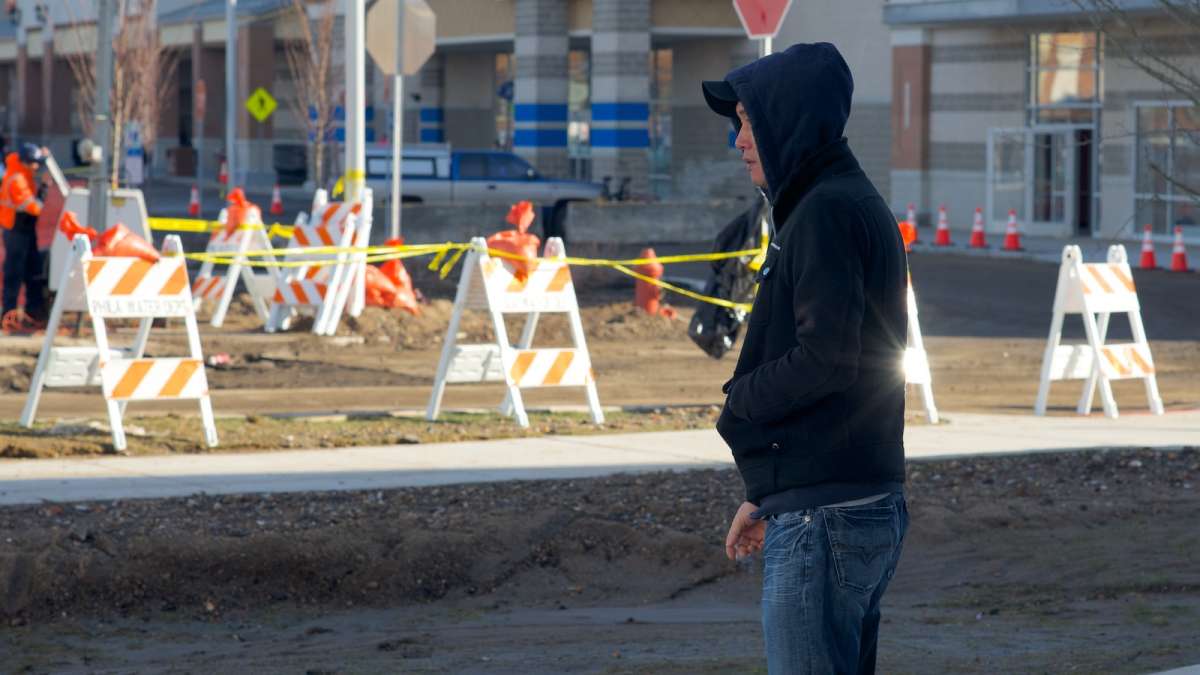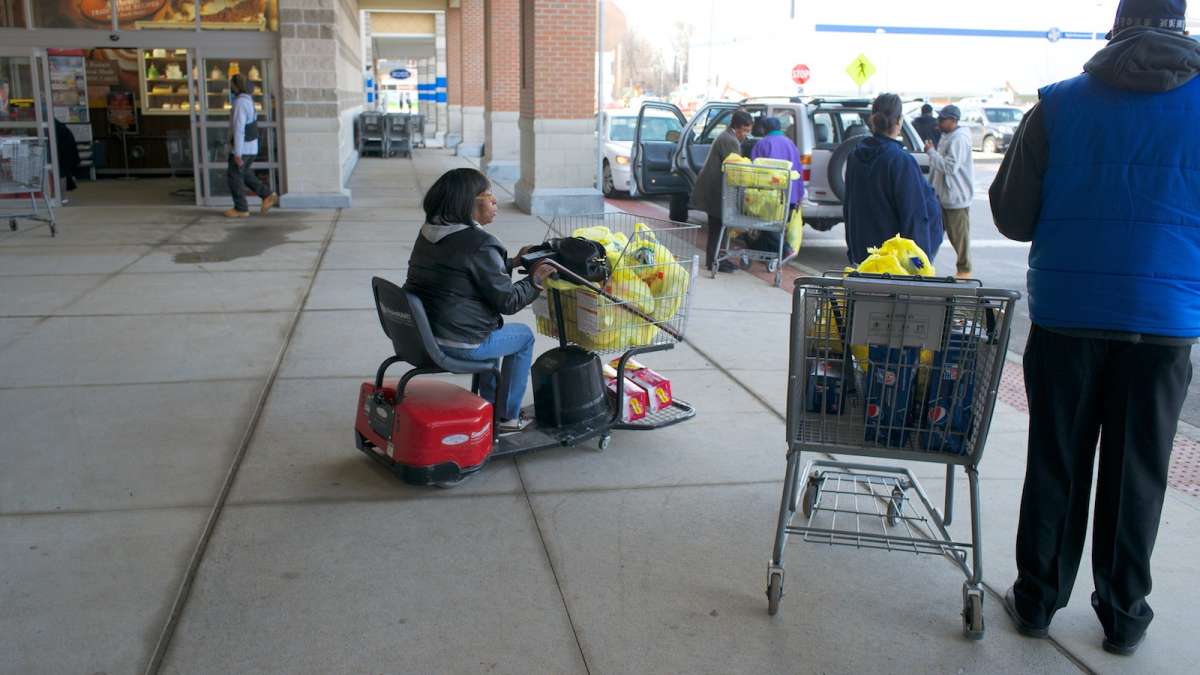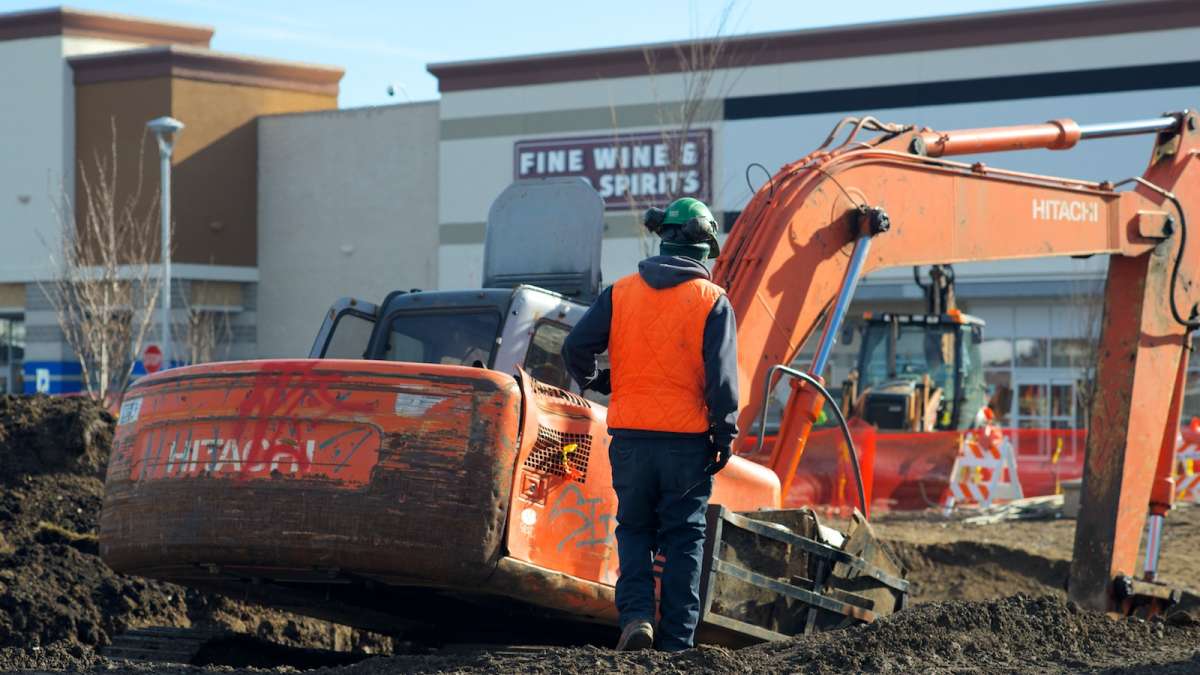Investigation into massive Bakers Centre water-main break continues
-

-

-

-

-

-

Hair Buzz owner Andy Kim watches PWD work at the site of the water-main break. (Bas Slabbers/for NewsWorks)
-

-

-

-

A scene from two days after the water-main break at East Falls' Bakers Centre. (Bas Slabbers/for NewsWorks, file)
-

-

Winter is water-main break season, and January has been a doozy.
On Jan. 12 alone, there were 25 main breaks across the city of Philadelphia, including a couple in Mt. Airy. For the most part they were breaks in small pipes, which are most susceptible to the cold weather.
In East Falls, it was a different story.
At Bakers Centre, the shopping plaza on 3400 Fox Street that opened last summer and takes its name from the old Tastykake bakery and warehouse, a 48-inch main ruptured at 4:30 a.m. Saturday Jan. 11. The pipe was turned off at 6:20 a.m., but not before spurting out 13 million gallons of water and resulting in a crater that was 80 feet long by 60 feet wide in the center’s parking lot.
The adjacent Ross and ShopRite stores were evacuated, and the water damaged the market’s walls, ductwork and electrical system. Both stores reopened by Sunday afternoon. But the neighboring Hair Buzz and Dollar Plus remained closed at mid-week. The center’s developer, Michael Grasso of Metro Development Co., estimated the damage to the parking lot alone at $3 million.
Local impact
Business owners and the developer, meanwhile, are assessing the damages to their stores. They can submit claim forms to insurance companies and the city’s Risk Management division.
But Pennsylvania law caps the city’s payouts at $500,000 per incident — meaning everyone affected by a main break divides that total amount.
State Sen. Larry Farnese, whose district includes the site of a severe break in Center City two years ago, introduced a bill in Harrisburg last summer to raise the cap, which was established 34 years ago, to $2 million.
“The state cap has been around a long time,” said the Philadelphia Water Department’s public affairs manager, Joanne Dahme. “It’s a concern of many people who feel it’s not enough.”
Larger issues
Breaks in smaller mains are often the result of the weather. When water temperature decreases in the cold, the ground expands while the pipes contract and become more brittle — particularly the older pipes in the city’s aging system.
But according to Dahme, the break in the large transmission pipe at Baker’s Centre may not have been due to the polar conditions that descended on the region last week.
Large pipes — which can be as much as 90 inches in diameter — are buried deeper and have thicker walls, and there are only about five transmission main breaks a year. The pipe under the parking lot, one of four large transmission mains in the area, dates back to 1895 and was approaching its life expectancy of 120 years.
The investigation into the cause of the break began with the excavation of the broken sections. PWD crews were digging 50 feet deep to reach the broken section, and had removed the damaged pieces by Monday Jan. 13. The next step involves analyses at an independent forensic lab which will take several weeks.
The investigation will also involve inspection of other pipes in the area to determine any impact the break may have had on them. And there were will be excavation to see if there is any danger to surrounding infrastructure in the shopping center.
Preventive measures
Dahme said PWD has a “robust prevention program” and replacement plan that looks at a variety of factors that can cause a main to break, including soil condition, depth, usage and corrosion. Breaks can also result from underground utility work. All these factors take a toll on the city’s pipes, which have an average age of 70 years.
The department inspects a thousand miles of main each year, about a third of the entire system, looking for defects and stress on the pipes. Cameras are inserted in the large pipes for visual inspections, and acoustical technology listens for leaks in the smaller pipes. A scoring process determines which are high-priority sections that “rise to the top for capital replacement,” Dahme said.
One method of protection utilized by PWD to guard against corrosion of the exterior of the pipes involves the use of a “sacrificial metal” connected to the area that requires protection. The sacrificial metal corrodes instead of the protected metal.
Flow tests are performed to identify interior corrosion, and the threatened lines are cleaned and lined with cement, which extends the life of the transmission mains.
Redistribution
When the main at Bakers Centre went offline last weekend, another transmission main took up the task and kept water service flowing to the shopping plaza and surrounding neighborhoods, PWD spokesman John DiGiulio said at the scene on Sunday.
“There is a redundancy built into the system that allows if one main is down, the other main picks up the service for distribution,” DiGiulio said.
Repairs involve removal of the broken main, installation of new sections, and testing of the pipe before it’s put back in service, he said. The timeframe for completion of the job will depend on the full assessment of the site.
NewsWorks has partnered with independent news gatherer PlanPhilly to provide regular, in-depth, timely coverage of planning, zoning and development news. Contact Alan Jaffe at alanjaffe@mac.com.
WHYY is your source for fact-based, in-depth journalism and information. As a nonprofit organization, we rely on financial support from readers like you. Please give today.






